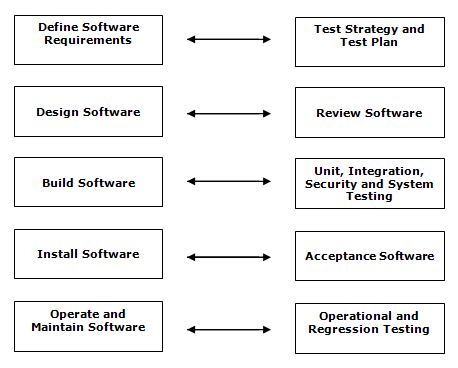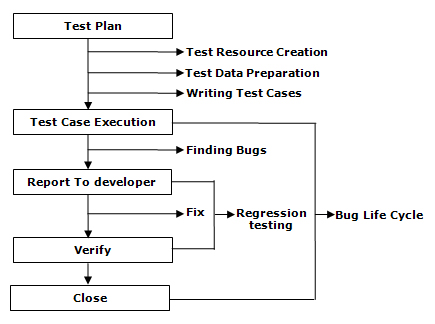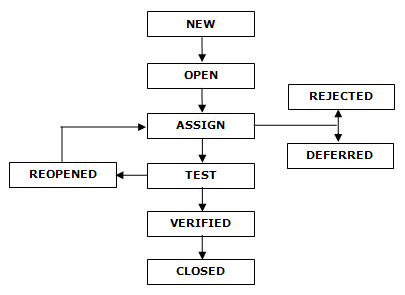Verilog Technology has quiet a vast experience in software testing field. Our Five-Step testing methodology has helped us to minimize project risk, streamlining testing releases. We start the testing course by developing a comprehensive test plan. The test plan includes the testing criteria for general functionalities along with specific requirements, on a number of platform combinations.
Methodology for Software Testing

Software testing engrosses operations on software to evaluate its results. Testing implies detecting bugs, and to check the correctness, completeness, security, and quality of software developed.
Our procedures are:
- Creating Test Plans, Test Cases
- User Interface Testing
- Compatibility Testing
- Configuration Testing
- Functionality Testing
- Product Specifications and User Documentation Review
- Provide Detailed Testing Status
Our test lab key benefits:
- We do onsite as well as offsite testing, saving your resources for other important tasks
- We work on project basis.
- We provide a thorough, top quality testing effort, ensuring your product's release readiness.
Software Testing Life Cycle

Functionality Testing
From module and unit testing through to final UAT –Our Company can assist you at every stage of Functionality Testing. Whether you require scripted or exploratory testing, Our Company have the expertise and experience to meet your needs and quality standards. Verilog can allocate dedicated resource for the entire project duration, and also ensures adequate resource enhancements, so that you may maximize efficiency, meet targets and contain overall costs. The work can be carried out on-site or from our state-of-the-art Development Centre in New Delhi, India depending on your requirements. Verilog employs best-practice tools and technologies to assist you in delivering a stable, high quality product which will serve its purpose and earn applauds from end-users.
Usability Testing
Visitors to your companies Website may have a wide range of Internet experience and, consequently, have different expectations which must be fulfilled to win them over. While experienced users look for implementation of industry norms, newcomers need guidance to surf through the unfamiliar Web environment. Failure to cater to such expectations is likely to result into lost sales, as visitors are unable to locate what they are looking for or unable to complete transactions.
Usability testing starts by identifying specific demographic groups within the target audience, taking into account their age, profession, cultural background, level of Internet exposure and many other relevant factors. At Verilog, we leverage our experience and expertise to evaluate Website; employ best industry practices to identify demographic profiles of users; and ensure optimum usability. We will provide a detailed analysis of usability issues, make recommendations and come up with solutions for each problem.
Compatibility Testing
Most organizations do not have adequate time or resources to subject an application or a Website to the most rigorous compatibility testing. It is, however, essential, as applications and Websites are expected to operate in myriad environments. Interoperability testing must be undertaken as well, with the range of applications your software/Website may have to co-exist with, or with which it may have to interface.
Verilog will prepare a risk-based assessment of the testing required and a cost-effective and efficient testing schedule. Our state-of-the-art Testing Centre in Chennai, India features a wide range of PCs and Macs, allowing hardware compatibility testing to be performed. Our software library, on the other hand, includes most popular operating systems, browsers, productivity suites, email clients and other software applications. Verilog's expertise in building different testing environments indicates that we are able to perform such tasks more efficiently than in-house testing teams while providing immediate time and cost benefits.
Performance Testing
Performance testing is the ideal mode to determine your Website or application's speed and reliability as the number of users increases rapidly. Our skilled test engineers will use state-of-the-art hardware and software to simulate up to tens of thousands of browsers requesting pages from your Website or application, exposing system performance issues before they occur. Verilog Uses a wide range of automated tools to handle stress and load testing aspects of Web performance. We will determine the overall reliability, as well as server and database scalability of your Website/application -- helping you meet current requirements and enabling you to plan for the future.
System and User Acceptance Testing
System testing usually refers to the testing of a specific system in a controlled environment to ensure that it will perform as expected and as required. From a Systems Development perspective, the term System Testing refers to the testing performed by the development team (programmers and other technicians) to ensure that the system works module by module (unit testing) and also as a whole.
System Testing should ensure that each function of the system works as expected and all errors (bugs) are detected and analysed. It should also ensure that interfaces for export and import routines will function as required. After meeting the criteria of the Test Plan, the software moves to the next phase of quality check and undergoes User Acceptance Testing.
User Acceptance Testing: UAT refers to the test procedures which lead to formal 'acceptance' of new or changed systems. User Acceptance Testing is a critical phase of any project and requires significant participation of 'End Users'. An Acceptance Test Plan is also developed detailing the means by which 'Acceptance' will be achieved. The final part of the UAT can also include a parallel run to compare the new system against the current one.
The User Acceptance Test Plan will vary from system to system but, in general, the testing should be planned in order to provide realistic and adequate exposure. The testing can be based upon User Requirements Specifications to which the system should conform. However, problems will continue to arise and it is important to determine what will be the expected and required responses from various parties concerned including Users, Project Team, Vendors and possibly Consultants/Contractors.
Bug Life Cycle

1. New: When the bug is posted for the first time, its state will be “NEW”. This means that the bug is not yet approved.
2 Open: After a tester has posted a bug, the lead of the tester approves that the bug is genuine and he changes the state as “OPEN”.
3. Assign: Once the lead changes the state as “OPEN”, he assigns the bug to corresponding developer or developer team. The state of the bug now is changed to “ASSIGN”.
4. Test: Once the developer fixes the bug, he has to assign the bug to the testing team for next round of testing. Before he releases the software with bug fixed, he changes the state of bug to “TEST”. It specifies that the bug has been fixed and is released to testing team.
5. Deferred: The bug, changed to deferred state means the bug is expected to be fixed in next releases. The reasons for changing the bug to this state have many factors. Some of them are priority of the bug may be low, lack of time for the release or the bug may not have major effect on the software.
6. Rejected: If the developer feels that the bug is not genuine, he rejects the bug. Then the state of the bug is changed to “REJECTED”.
7. Duplicate: If the bug is repeated twice or the two bugs mention the same concept of the bug, then one bug status is changed to “DUPLICATE”.
8. Verified: Once the bug is fixed and the status is changed to “TEST”, the tester tests the bug. If the bug is not present in the software, he approves that the bug is fixed and changes the status to “VERIFIED”.
9. Reopened: If the bug still exists even after the bug is fixed by the developer, the tester changes the status to “REOPENED”. The bug traverses the life cycle once again.
10. Closed: Once the bug is fixed, it is tested by the tester. If the tester feels that the bug no longer exists in the software, he changes the status of the bug to “CLOSED”. This state means that the bug is fixed, tested and approved.
While defect prevention is much more effective and efficient in reducing the number of defects, most organization conducts defect discovery and removal. Discovering and removing defects is an expensive and inefficient process. It is much more efficient for an organization to conduct activities that prevent defects.
